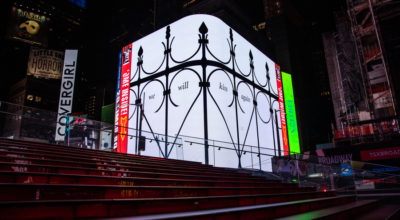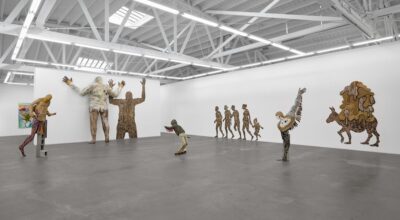
Beatriz Cortez Envisions a World Outside The Confines of Western Civilization
The Craft & Folk Art Museum (CAFAM) presents Beatriz Cortez: Trinidad / Joy Station, the El Salvador-born, Los Angeles-based artist’s first major solo museum exhibition. With this presentation, Cortez imagines a space of communal living that is dedicated to multicultural coexistence, the survival of indigenous peoples, and experiences of joy.
Imagined as a space station consisting of multiple geodesic structures that can be viewed from outside or experienced as interiors, a living indigenous food garden, and other communal spaces, Cortez envisions a world outside the confines of Western civilization.
Cortez references geodesic dome architecture associated with the post-war utopian community Drop City, built in Trinidad, Colorado during the 1960s, as well as the collective living practices of the ancient Mayan village Joya de Cerén in what is present-day El Salvador. The exhibition acts as a record of the trajectory of human civilization, including the devastation of the planet and the celebration of survival. Cortez aims to recycle destructive elements of Western capitalist society to build alternative spaces of coexistence and communalism.
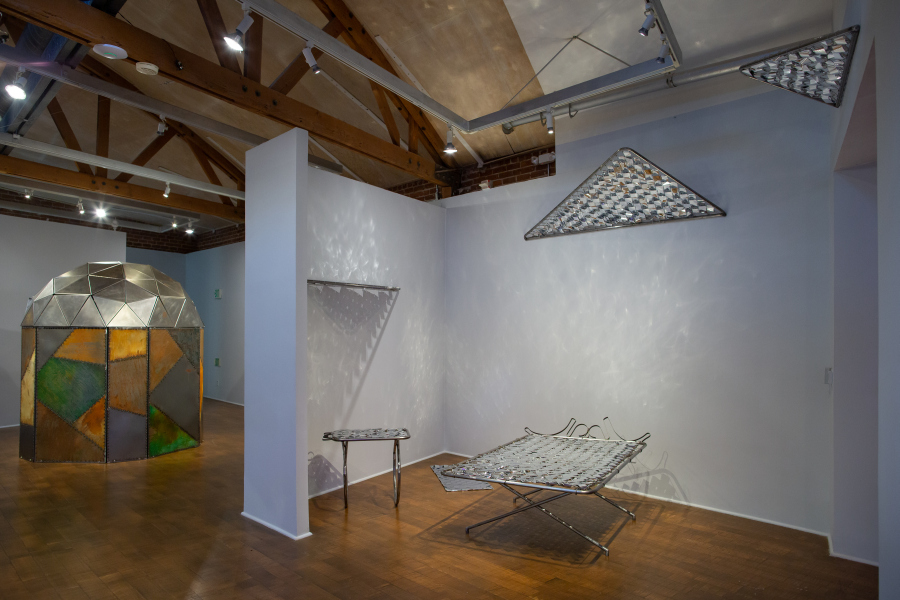
Beatriz Cortez, Trinidad: Joy Station (installation view at Craft Contemporary), 2019. Courtesy of the artist and Commonwealth and Council, Los Angeles / Photo: Gina Clyne.
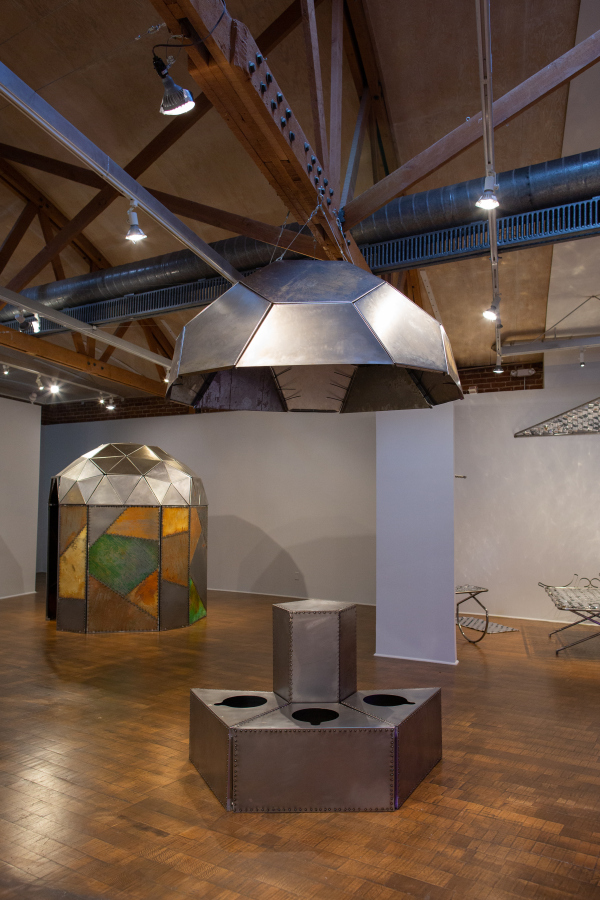
Beatriz Cortez, Trinidad: Joy Station (installation view at Craft Contemporary), 2019. Courtesy of the artist and Commonwealth and Council, Los Angeles / Photo: Gina Clyne.
“Cortez melds multiple references into structures and materials that offer solutions to the social and environmental devastation inflicted by capitalism and Western global dominance,” says CAFAM exhibitions curator Holly Jerger. “By looking to the past and creating beauty from devastation, Cortez proposes a future built on equitable, communal living that provides care, growth, and happiness to its inhabitants.”
A cylindrical steel structure called Jumbo (2018) is named for the gigantic container that housed the first atomic bomb detonated in New Mexico. Instead of a bomb, the container is imagined as a seed repository that enables the reproduction of life and nourishment. Cortez also references the economic and environmental impacts of the car industry through her dome structures made from salvaged car hoods, marked with colorful patinas of use and wear. Most chillingly, she has created beds that allude to the current caging of refugee children in immigration detention centers through her choice of materials: chain-link fencing and mylar surfaces.
“I imagine joy, especially shared joy, as a way to resist capitalism,” says Cortez. “And I imagine the collapse of chronologies and try to experience time as simultaneities and circular motions as a way to resist colonialism.”
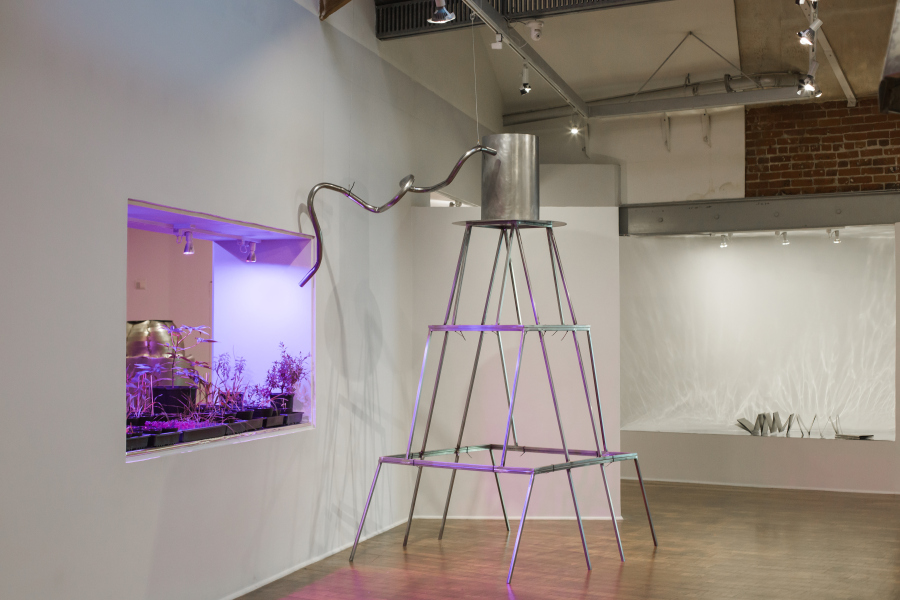
Beatriz Cortez, Trinidad: Joy Station (installation view at Craft Contemporary), 2019. Courtesy of the artist and Commonwealth and Council, Los Angeles / Photo: Gina Clyne.

Beatriz Cortez, Trinidad: Joy Station (installation view at Craft Contemporary), 2019. Courtesy of the artist and Commonwealth and Council, Los Angeles / Photo: Gina Clyne.
An additional presentation by Cortez in collaboration with Los Angeles-based artist Rafa Esparza called Nomad 13 is on view on the museum’s first floor. Nomad 13 takes the form of an unconventional space capsule built from adobe bricks and steel that houses a garden of plants indigenous to the Americas. The garden refers to a long history of plant migration, as well as the knowledge and technological advances of ancient peoples.
Cultivated by the Inca, Maya, and Aztec civilizations, the ancient species of plants are known for their wholesome nutritional qualities and profound spiritual meanings. In symbolically sending these plants into the cosmos, the artists evoke the real ongoing experiments of NASA (National Aeronautics and Space Administration) to grow food in outer space. However, with Nomad 13 the artists wish to ensure the growth of fresh food in space for the survival of indigenous knowledge and to nourish future space travelers.

Beatriz Cortez and Rafa Esparza, Nomad 13 (installation view at Craft Contemporary), 2019. Adobe bricks, steel, plastic, paper, soil, and plants. Courtesy of the artists and Commonwealth and Council, Los Angeles /
Photo: Gina Clyne.
BEATRIZ CORTEZ: TRINIDAD / JOY STATION
Craft & Folk Art Museum, 5814 Wilshire Blvd., Los Angeles, California
Until May 12, 2019
También te puede interesar
PEDRO REYES AND OTHER ARTISTS JOIN CAMPAIGN IN SUPPORT OF ESSENTIAL WORKERS
Times Square Arts, For Freedoms and Poster House just launched a multi-city campaign, which is on view on digital displays throughout all five boroughs of New York City and on JCDecaux screens in New...
HECTOR DIONICIO MENDOZA: BUSCANDO FUTURO
As an artist, curator, and educator based in the agricultural community of the Salinas Valley in California, Dionicio Mendoza (b.1969, Uruapan, Michoacan, MX) embraces Latinx/e futurism while exploring themes of migration and the environment,...
EDDIE RODOLFO APARICIO: ESPINAS AMOROSAS
For Aparicio, rubber itself exudes the symmetry between the commodification of indigenous material culture and the exploitation of Latin American countries for labor and resources. Restored to its natural function, it also suggests a...

